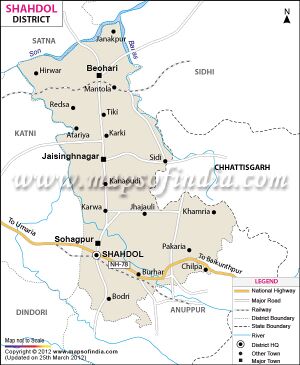Beohari
| Author:Laxman Burdak, IFS (R) |

Beohari is a town and tahsil in Shahdol district in Madhya Pradesh.
Variants
Location
It is 79.07 kilometres from the main district of Shahdol and 412 kilometres away from Bhopal, the state capital. Its geographical coordinates are 24° 3' 0" North, 81° 23' 0" East.
There are direct connections to major cities. Beohari is an important station on the Katni to Howrah route, which is 112 km from Katni and 149 km apart from Singrauli.
Origin
Jat Gotras Namesake
Villages in Beohari Tahsil
Towns: 1 Beohari, 2 Khand Nagar
Villages:
1 Akauri, 2 Akhetpur, 3 Alhara, 4 Ambar 13, 5 Amilgarh, 6 Anahra, 7 Bagdari, 8 Baheriya, 9 Bairihai, 10 Banasi, 11 Bara, 12 Bara Baghelaha, 13 Baraha Tola, 14 Barahtha, 15 Barhai, 16 Bedra, 17 Belbahra, 18 Bhamraha, 19 Bhamraha, 20 Bhanni, 21 Bholehara, 22 Bhulehri, 23 Bijaha, 24 Bijahi, 25 Bijuriha, 26 Bilkuda, 27 Bocharo, 28 Boddiha, 29 Bokra Bokri, 30 Budwa, 31 Chachai, 32 Charka, 33 Charkhari, 34 Chauri, 35 Chhataina, 36 Chhatwa, 37 Chhiraha, 38 Chhuhi, 39 Chhula Kachhar, 40 Chitrasi, 41 Dadar, 42 Dalko Jagir 43 Dalko Kothar, 44 Davraunha, 45 Deogaon, 46 Deorao, 47 Deori, 48 Devarda, 49 Dhandho Kui, 50 Dhari No 1, 51 Dhari No 2, 52 Dheka, 53 Duara, 54 Durgapur, 55 Gada, 56 Ganjar, 57 Ghinauchi, 58 Gopalpur, 59 Hanumanpur, 60 Hathwar, 61 Hinauta, 62 Hirwar, 63 Indwar, 64 Jagmal, 65 Jamodi, 66 Jamuni, 67 Jamuniha, 68 Janakpur, 69 Jharaunsi, 70 Jhiriya, 71 Judmani, 72 Kalhari, 73 Karaundiya, 74 Karhi, 75 Khadda, 76 Khadeh, 77 Khadhuli, 78 Khaira, 79 Khamdand, 80 Kharapa, 81 Kharhara, 82 Khari, 83 Khari Badi, 84 Khari Chhot, 85 Khusariya, 86 Khutehara, 87 Kumhiya, 88 Kuwa, 89 Kyotiha, 90 Lalpur, 91 Magardaha, 92 Mahdeva, 93 Mair, 94 Mair Tola, 95 Martala, 96 Mau, 97 Nado, 98 Nakuni, 99 Naudhiya, 100 Nimiha, 101 Nipaniya, 102 Nipaniya, 103 Nipaniya, 104 Odari, 105 Padri, 106 Papaundh, 107 Papodh, 108 Papredi, 109 Pasgari, 110 Pathrehi, 111 Paweh, 112 Pondi Khurd, 113 Rampurwa, 114 Raspur, 115 Reusa, 116 Sakandi, 117 Sakhi, 118 Saman, 119 Sapta, 120 Sarsi, 121 Sarwahi Kalan, 122 Sarwahi Khurd, 123 Sathni, 124 Satkhuri, 125 Sejhari, 126 Shahargarh, 127 Sukha, 128 Sukhad, 129 Tanghar, 130 Tenduha, 131 Tikhawa, 132 Tikura Tola, 133 Ujrabara, 134 Uksa, 135 Umargarh, 136 Vijaysota,
Source - https://www.census2011.co.in/data/subdistrict/3689-beohari-shahdol-madhya-pradesh.html
History
The name "Beohari" stems from the title-prefix "Beohar", which signifies that the town was founded by a member of the Beohar dynasty. The Beohars were Rani Durgavati's prime ministers and knight-commanders, and Jagirdars of Jabalpur and their descendants continue to live there. The most notable of the Beohars is Sardar-Beohar Adhar Simha, who represented the Gond kingdom in Emperor Akbar's court, and the last Jagirdar of Jabalpur was Beohar Raghuvir Sinha. Different members of the Beohar lineage founded different settlements called Beohari, which are scattered in the Mahakoshal region of Madhya Pradesh.
Economy
Beohari is rich in mineral resources, including marble, iron ore, clay, sand and unexplored petroleum products. Beohari is economically rich and is politically active since Independence.
Agriculture is the chief economic occupation in Beohari. In recent years[when?], mustard farming has become one of the most harvested crop in Beohari due to balanced temperatures and the soil, which is loose, friable and deep.
The main crops are paddy; cereals like maize, sorghum, kodo-kutki and other small millets; pulses like tuar and udhad; and oil seeds like til, groundnut, soya-bean and sunflower.
Most of the region's population is dependent on agriculture. Mainly the tribals are marginal farmers who prefer the cultivation in the old traditional method.
Being a mountainous area, only 9% of the total crop gets irrigation. The area irrigated by canals, tubewells, dugwells and tanks. Some part of the place are in the shore of the Banas River and Jhapar River. In this area was mainly production of wheat and rice in India. In Beohari the highest number of growing wheat. A dam was built in this area in 2001.
Forests: Sal, amla, teak, sarai and shisham are the main trees found in this area. The flowera of mahua and guli provide edible oi

